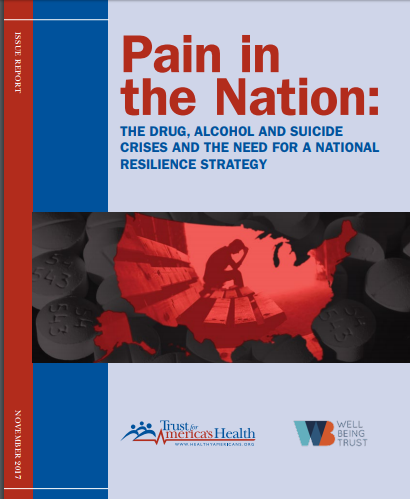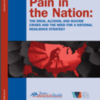In 2015 alone, 127,500 Americans died from drug- or alcohol-induced causes or suicide. That is 350 deaths per day, 14 per hour, and one person dying a preventable cause every four months. Projections say it will only get worse.
But there are solutions if we choose to act. A full scale National Resilience Strategy can move us in the right direction.
Deaths from drugs, alcohol and suicide could account for 1.6 million fatalities over the coming decade (2016 to 2025) according to a new report, Pain in the Nation: The Drug, Alcohol and Suicide Epidemics and the Need for a National Resilience Strategy, released by the Trust for America's Health (TFAH) and Well Being Trust (WBT). From 2006 to 2015, there were 1 million deaths from these three causes.
This would represent a 60 percent increase compared to the past decade, if recent trends hold. The study found, however, that these numbers may be conservative, especially with the rapid rise of heroin, fentanyl and carfentanil use. If the nation continues along recent trajectories, death rates would actually double to 2 million by 2025.
Pain in the Nation calls for the creation of a National Resilience Strategy that takes a comprehensive approach by focusing on prevention, early identification of issues and effective treatment. The report highlights more than 60 research-based policies, practices and programs.
State specific information and data breakdowns:
r suicide. That is 350 deaths per day, 14 per hour, and one person dying
Pain in the Nation calls for the creation of a National Resilience Strategy that takes a comprehensive approach by focusing on prevention, early identification of issues and effective treatment. The report highlights more than 60 research-based policies, practices and programs, including:
Address the Impact of the Opioid Epidemic on Children – and the Need for a Multi-Generational Response that includes substance use disorder treatment for parents and wrap-around services for children and families, including grandparents and other relatives who help care for children, and expand support for the foster care system
Prevent Suicides by expanding crisis intervention services; anti-bullying and social-emotional learning in schools; and support systems for Veterans; and better integrating mental health into primary care,
Prioritize Prevention, Reduce Risk Factors and Promote Resilience in Children, Families and Communities by limiting trauma and adverse experiences, which have the biggest long-term impact on later substance misuse, and promoting better mental health.act on later substance I\
Reboot Substance Misuse Prevention and Mental Health in Schools by scaling up evidence-based life- and coping-skills programs and inclusive school environments and increasing the availability of mental health and other services.
The report was supported by grants from Well Being Trust (WBT) and the Robert Wood Johnson Foundation (RWJF). Data analysis and projections were provided by the Berkeley Research Group. The full report is available on Trust for America's Health (TFAH) website at www.healthyamericans.org
cause every four minutes. Projections say it will only get worse.






Comments (1)